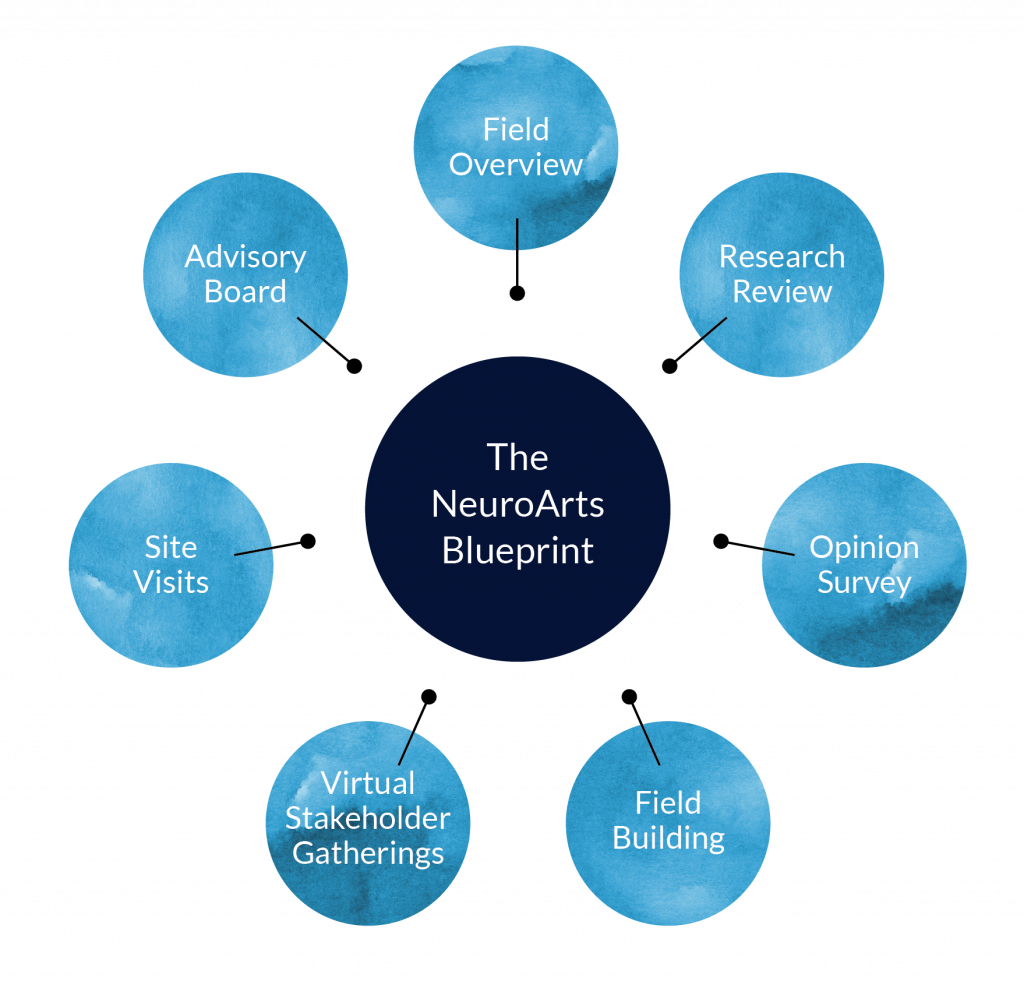The NeuroArts Blueprint: Advancing the Science of Arts, Health, and Wellbeing initiative is breaking new ground at the crossroads of science, the arts, and technology. Its mission is to cultivate an ecosystem for neuroarts, defined here as the transdisciplinary and extradisciplinary study of how the arts and aesthetic experiences measurably change the body, brain, and behavior, and how this knowledge is translated into specific practices that advance health and wellbeing. To realize its potential, neuroarts must become a fully recognized field of research and practice, with educational and training pathways, dedicated funding, supportive public sector and private sector policies, effective leadership, wellcrafted communications strategies, and infrastructure capacity.
The Blueprint initiative, launched in 2019, is designed to put all of that in place. A partnership between the Johns Hopkins International Arts + Mind Lab Center for Applied Neuroaesthetics and the Aspen Institute’s Health, Medicine & Society Program, the initiative engages leaders across a wide range of disciplines, as well as people with lived experience. Together, they are helping to drive the paradigm shift necessary to fully integrate arts and aesthetic experiences into activities that will advance individual and collective health across the planet.
The NeuroArts Blueprint is building a community of researchers, arts practitioners, artists, community knowledge keepers, and other allies who understand the imperative of using art as a science-based tool to advance our collective health and well-being.
The NeuroArts Blueprint is an authoritative, first-of-its-kind roadmap to move this field into widespread use. Released in December 2021, it charts advances in brain science, identifies gaps in knowledge, policy and funding, and documents effective and replicable practices in order to create the conditions for a deep commitment to neuroarts, in all its transformative power. The implementation phase is underway to scale up the research, training, and practice components of the field.
Key components of the community-building process that have informed the Blueprint include:

To inform our work, the NeuroArts Blueprint initiative:
- Assembled a diverse 25-member Advisory Council
- Conducted in-depth literature reviews and analyses (NeuroArts Today: State of an Emerging Field);
- Held eight stakeholder convenings to explore communications, policy, practice, research, and technology, including two with a global focus
- Commissioned and published an economic analysis (Alzheimer’s Disease and Music Engagement Economic Impact Analysis) and a 300-person survey of neuroarts stakeholders (Findings from an Online Survey of Stakeholders);
- Published a World Bank report that linked art to economic development (Human Capital and the Arts at the World Bank Group); and
- Exchanged ideas with hundreds of other experts and stakeholders.
With these steps, the NeuroArts Blueprint initiative has identified gaps in knowledge and practice and recommended strategies for closing those gaps. It is designed to serve as a catalyst to mobilize the full power of art. What stands in the way of action? How can we be deliberate in removing those obstacles? How do we illuminate the field so that all can recognize its potential? The Blueprint helps to answer those questions.

The NeuroArts Blueprint builds on the evidence to provide a roadmap forward. It offers five principles, five findings, and five recommendations, accompanied by key action steps, to guide the multiyear process of developing a neuroarts ecosystem:
Five Principles
- Experiencing art is fundamental to being human, a common thread across cultures, racial and ethnic backgrounds, age groups, income levels, and skill sets. The arts offer a shared language, a means of elevating diverse voices, and a catalyst for action.
- The arts, as expressed through many modalities, have demonstrable, evidence-based impacts on physiological and psychological health and wellbeing.
- Science and technology make possible the ability to understand and measure the biological effects of the arts and aesthetic experiences on individuals and populations.
- Neuroarts provides the connective tissue to bring together science, the arts, and technology as equal partners to advance health and wellbeing.
- The benefits of the neuroarts field must be readily, consistently, and equitably accessible to all populations across the lifespan and in every community around the world.
Five Findings
- The arts and aesthetic experiences impact human biology and behavior in ways that differ markedly from any other health intervention.
- Preliminary evidence suggests that the neuroarts field provides economic and social benefits.
- Neuroarts-related activities are everywhere, but they lack a cohesive structure.
- Now is the moment to cultivate the field of neuroarts.
- Leadership and community-based engagement are essential for neuroarts to progress.
Five Recommendations
- Strengthen the research foundation of neuroarts.
- Honor and support the many arts practices that promote health and wellbeing.
- Expand and enrich educational and career pathways.
- Advocate for sustainable funding and promote effective policy.
- Build capacity, leadership, and communications strategies.
The NeuroArts Blueprint lays out a collaborative action plan to implement these recommendations and ultimately to develop a new paradigm that explains how health and wellbeing are achieved.
In the first five years, we will measure success by the extent to which we assemble the elements of an interdependent, fully operational neuroarts ecosystem—a defined community of stakeholders, an established theory of change, shared language, agreed-upon outcome measures, and a well-defined mission. Effective framing, messaging, and communications are also fundamental.
As more transdisciplinary research flows through the pipeline and evidence-based pilot programs are scaled, we will see ever-greater synergies between science and arts practice. To become sustainable over the long term, neuroarts must foster institutional commitments—from governments, across global organizations, among scientific and arts bodies, and in academic, workplace, healthcare, and community settings.
Together, we can achieve the culture change that will drive better health for all.
